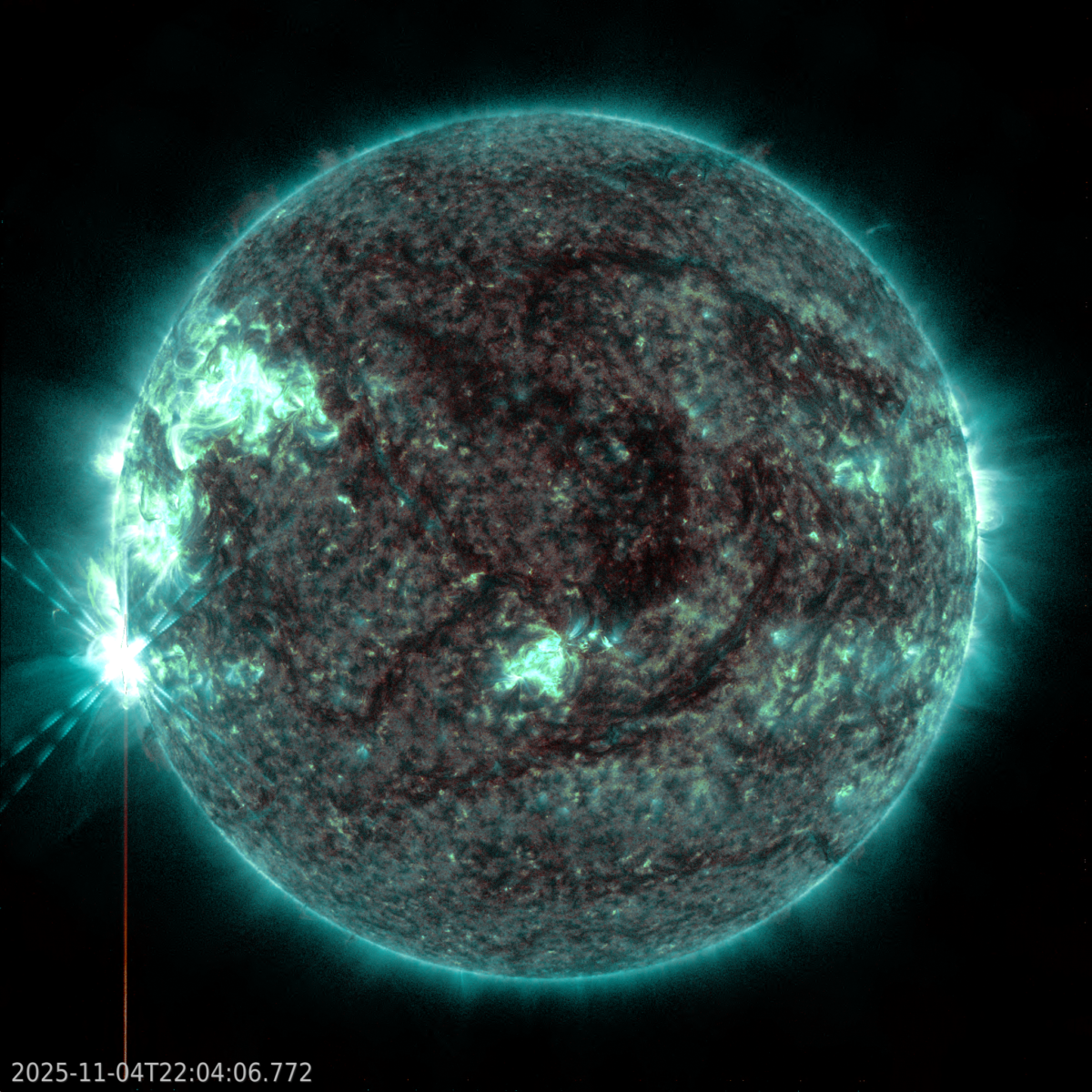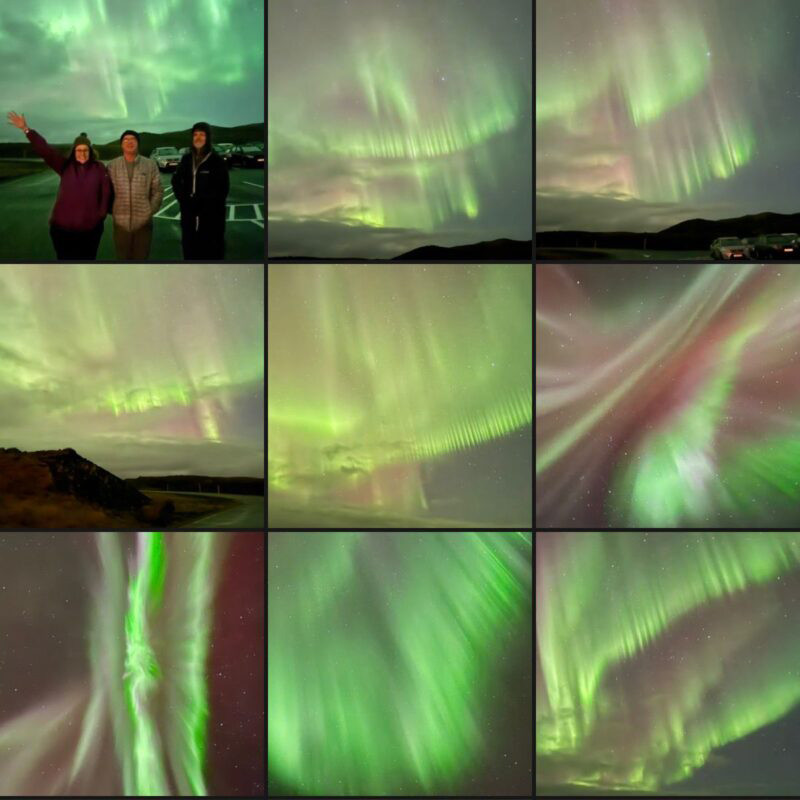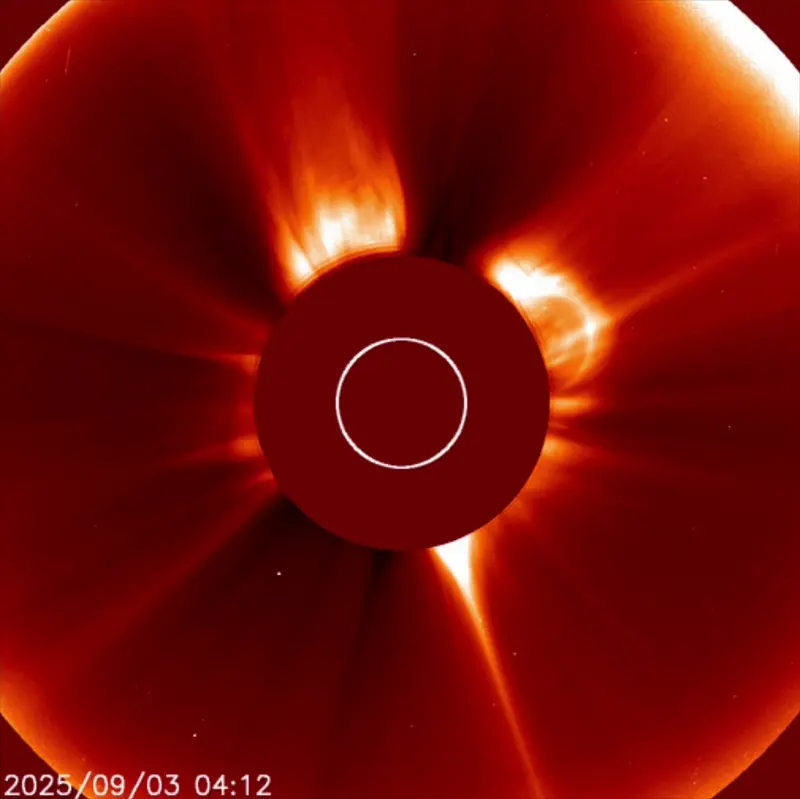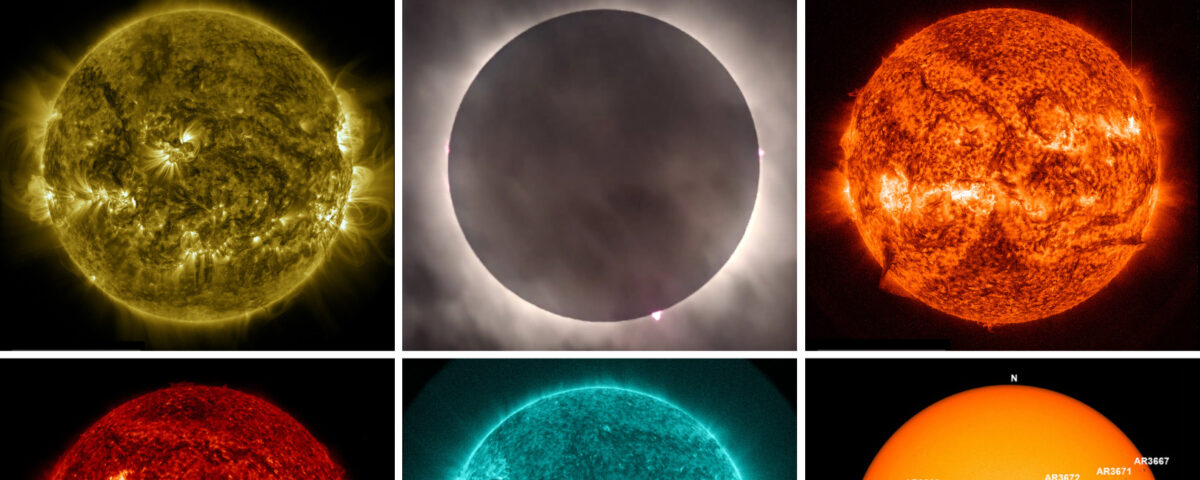

To celebrate 2024, we’ve compiled a list of the best solar events based on three criteria: visual appeal, scientific significance, and impact on people.
Top 10
- 10: Beautiful Eruption of a Solar Filament
- 9: The Solar Dynamics Observatory Sees an Eclipse of the Sun
- 8: A Solar Tornado
- 7: The Peak of Solar Cycle 25
- 6: 2nd Biggest Flare of 2024 and Solar Cycle 25
- 5: October 2024 Super Storm
- 4: Biggest Flare of 2024 and Solar Cycle 25
- 3: Total Solar Eclipse
- 2: Parker Solar Probe Makes Closest Approach to the Sun
- 1: May 2024 Super Storms
Honorable Mentions
10: Beautiful Eruption of a Solar Filament
June 4, 2024
- This event was chosen for its fascinating appearance in the Solar Dynamics Observatory’s 304 and 171 extreme ultraviolet wavelengths.
- It also shows the Sun’s magnetic fields and how material from the Sun’s atmosphere responds to them.
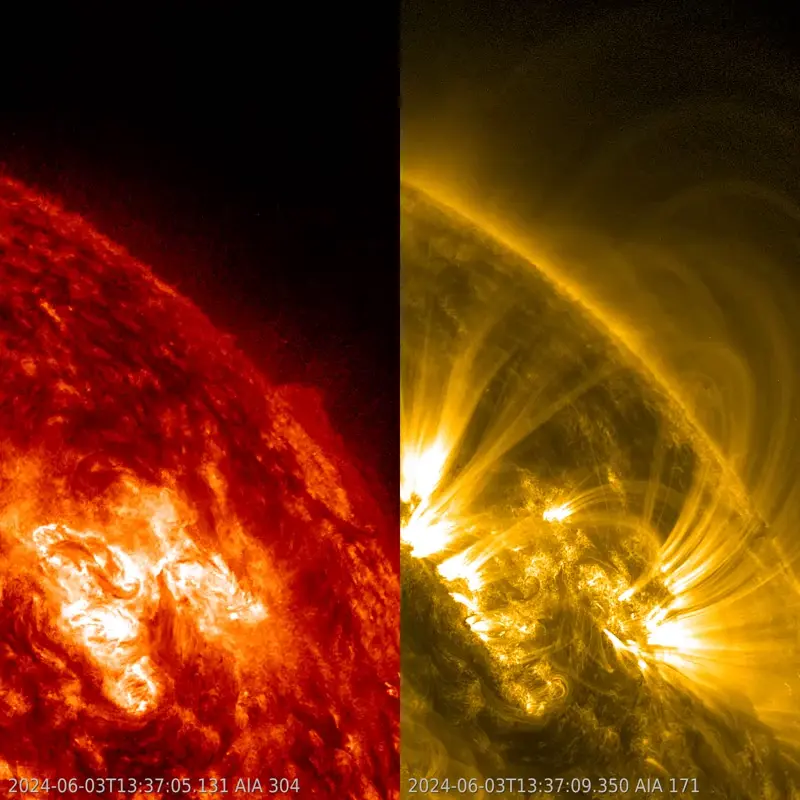
An eruption from the Sun, captured by the Solar Dynamics Observatory, is shown in two extreme ultraviolet wavelengths. The red image (304 angstroms) and the gold image (171 angstroms) display a sigmoid (S-shaped) filament over sunspot region AR3695. The filament erupted, producing an M4.8 flare and sending a plasma blob into space. The sigmoid shape is most visible in the red (304 angstrom) image. Image via SDO.
Around noon Universal Time on June 3, a solar filament erupted from the Sun. Filaments, seen as dark S-shaped structures in certain light, store a lot of energy, like a twisted metal spring ready to snap back. When the filament released, it triggered a bright solar flare, which pushed the filament outward. However, much of the solar material fell back to the Sun’s surface. The filament’s twist may have caused the flare, similar to how an unwinding spring could set off a mousetrap and then be launched away.
A fascinating aspect is how the solar material follows curved magnetic field lines. This happens because the material is plasma, which interacts with magnetic fields. These fields originate from sunspots and, while usually invisible, are highlighted by the glowing plasma. In gold 171 images, the glowing plasma shows the shape of the magnetic fields, much like iron filings reveal a magnet’s field when sprinkled over it.
9: The Solar Dynamics Observatory Sees an Eclipse of the Sun
July 15, 2024
- This event was chosen because of the fun video of the fuzzy Earth shadow blocking out the Sun in four different extreme ultraviolet wavelengths, 304, 171, 193, and 131 angstroms.
- It shows an eclipse that can only be observed in space as well as the effect on the shadow created when the blocking object (Earth) has an atmosphere and not a sharply defined edge.
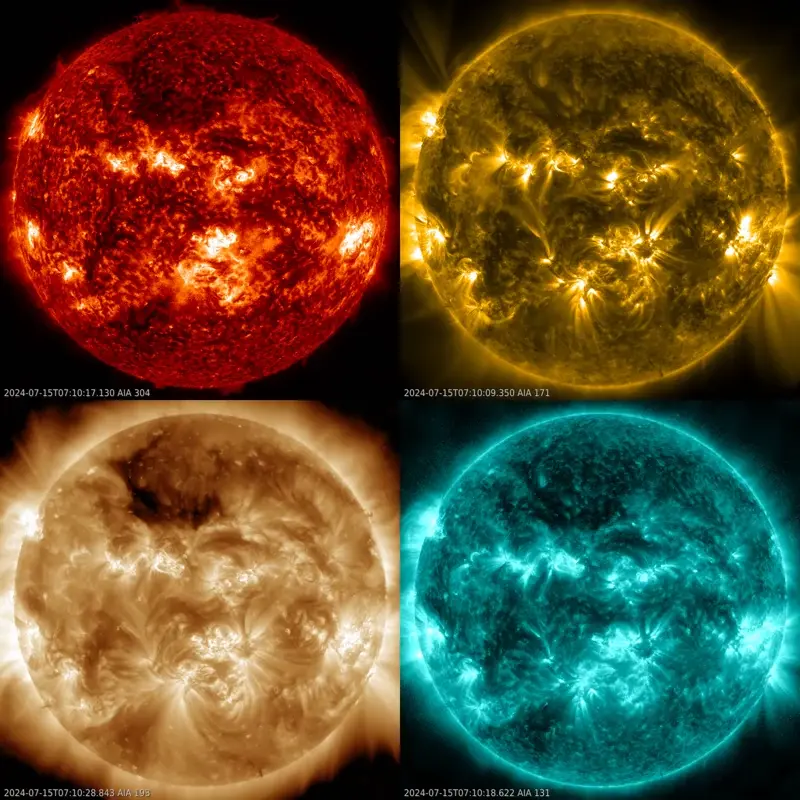
The Solar Dynamics Observatory (SDO) began its 29th eclipse season at 7:17 UTC, July 15, 2024. What’s blocking the sun? It’s the Earth! This sequence shows the eclipse in four wavelengths, 304, 171, 193, and 131 angstroms. Image via SDO and JHelioviewer.
The Solar Dynamics Observatory (SDO) experiences its own eclipse seasons twice a year, each lasting 3–4 weeks. During these times, Earth briefly blocks the Sun from the spacecraft’s view. Eclipses start at about 30 minutes long, peak at 72 minutes long, and then decreasing. The eclipse season show here (#29) ended on August 11, and the next (#30) begins on January 10, 2025. The eclipses happen because the spacecraft’s inclined geosynchronous orbit around Earth is designed to maximize its time looking at the Sun, meaning that twice a year Earth gets in the way.
Unlike solar eclipses on Earth, where the Moon blocks the Sun, SDO’s eclipses are caused by Earth. Earth’s larger size and atmosphere create a fuzzy edge, unlike the sharp outline of the Moon. These eclipses are observed in extreme ultraviolet light, a wavelength that cannot be seen from Earth because our atmosphere blocks it.
8: A Solar Tornado
September 16, 2024
- This event combines two different SDO images we often use, 304 and 171 angstroms, into one image, providing a new view of this type of phenomena.
- Similar to number 10, this is also an erupting filament but here the unraveling of it looks like a tornado, hence the name.
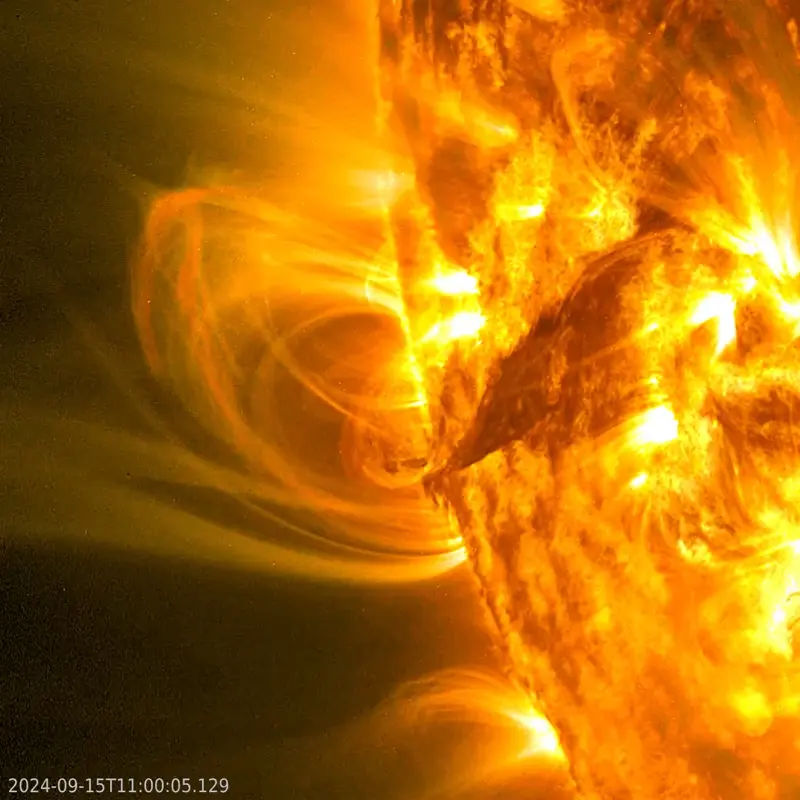
A nice filament near AR3824 is flickering and twisting, captured with SDO’s 304 and 171 angstrom wavelengths. Images via SDO and JHelioviewer
The Solar Dynamics Observatory (SDO) captured a filament flickering and twisting, appearing ready to erupt. Unlike a similar structure seen earlier, this filament is next to a sunspot, not on top of it, and is intertwined with a magnetic field. It looks like a twisted rope that unravels as it rises, creating the illusion of a giant tornado. Scientists call these “solar tornadoes,” but they are very different from tornadoes on Earth.
Recent research shows that “solar tornadoes” don’t actually spin. They are stationary magnetic structures filled with hot plasma, and their twisting motion is an optical illusion caused by projection effects, much like how airplane contrails can appear to touch the horizon.
7: The Peak of Solar Cycle 25
September 3, 2024
- This animation combines two different wavelengths of full sun images, the SDO visible light Sun showing sunspots (dark areas) overlaid with the teal SDO 131 angstrom extreme ultraviolet images showing the regions over sunspots and solar flares (brightenings).
- The sequence of images shows the Sun over the entire month of August 2024. It shows two bands of sunspots above and below the equator, with most of the sunspots in the southern hemisphere.
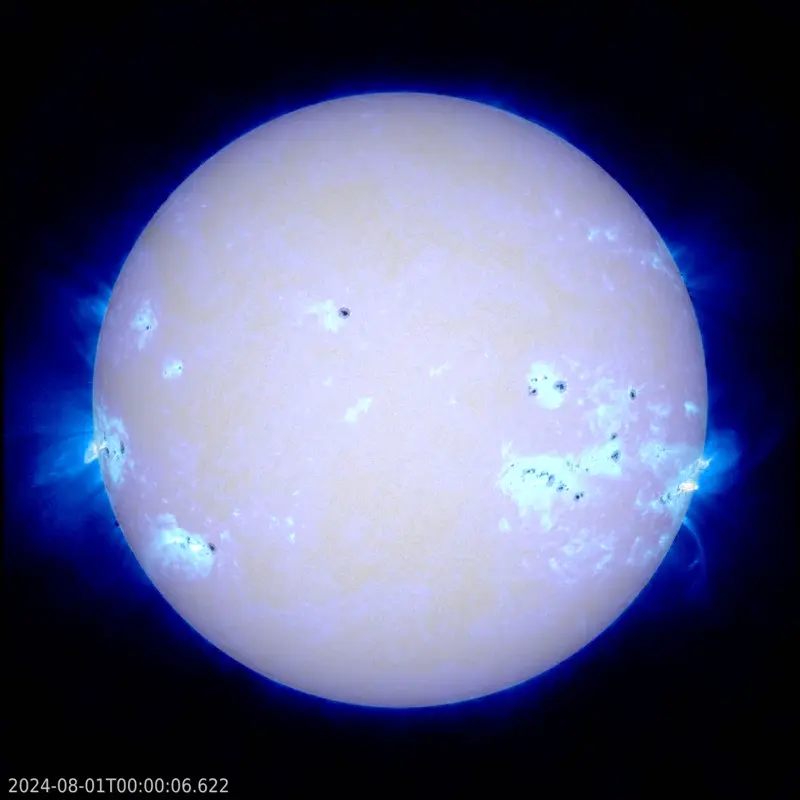
August 2024 has the highest monthly sunspot number currently for Solar Cycle 25 and the highest for 2024. It’s the highest number since September 2001, 23 years ago. This image shows a month of sunspots for August 2024 in SDO visible light showing sunspots overlaid with SDO 131 angstrom light showing flares as brightenings. Image via NASA and JHelioviewer.
The monthly sunspot number for August 2024 remains the highest of the year and Solar Cycle 25. In August 2024, the sunspot number reached a value of 215.5. This surpassed the previous peak for this solar cycle in July 2024, which had a value of 196.5. The last time the monthly average exceeded 215.5 was 23 years ago, in September 2001, during Solar Cycle 23, when it reached a value of 238.2. Shortly after this finding was reported in early September, the joint NASA/NOAA Solar Cycle 25 Panel announced that we had entered solar maximum. Solar maximum typically lasts between 2 to 4 years. The peak of the solar cycle is marked by the month with the highest sunspot number. August seems to be that month, although a final determination is usually made 6 months to a year after the monthly peak. Time will tell.
6: 2nd Biggest Flare of 2024 and Solar Cycle 25
May 14, 2024
- This is the first set of images in our list that combines two different spacecraft, four different extreme ultraviolet wavelengths from SDO showing the flare and the Solar Heliospheric Observatory (SOHO) coronagraph images near the end of the video showing the coronal mass ejection leaving the Sun after the flare.
- These images start with a good set of four SDO wavelengths, especially helpful for observing solar flares, showing them individually, then some combined with SOHO coronagraph images.
This video shows the May 14 X8.8 flare, first in a set of four SDO wavelengths (193,131,94, and 335 angstroms). Then we see the same wavelengths one at a time. These wavelengths are sensitive to the hottest plasma which is created by the solar flare making them then best choice for observing the event. There is also a blob from the Sun, a coronal mass ejection (CME), shot out the side. The SOHO coronagraph which is basically an artifical eclipse is one of the best ways to observe the CME moving away from the Sun.
At 16:51 UTC on May 14, 2024, the 2nd largest solar flare of 2024 and Solar Cycle 25 occurred—an X8.8 flare! It was produced by the departing sunspot region AR3664, just as the sun’s rotation was about to carry the region completely out of view. Part of the region was already hidden behind the sun’s edge, so the flare was even larger than observed.
The ESA/NASA Solar Orbiter, which had a view of the sun’s far side, captured the X8.8 flare and estimated that it might have been as large as X18 confirming the flare was larger than observed from Earth. This X8.8 flare is now considered historic—it ranks as the 17th largest solar flare ever recorded and is slightly bigger than the infamous Bastille Day Flare from July 14, 2000. If the Solar Orbiter’s estimate is accurate, the flare could be one of the top five solar flares observed since 1979, when the GOES spacecraft began measuring solar activity.
5: October 2024 Super Storm
The Events at the Sun
October 9, 2024
- This event focuses primarily on the use of the two SOHO coronagraphs, the inner one (red) and the outer one (blue). This gives some perspective on how big these coronal mass ejections (CMEs) are as they leave the Sun. These coronal mass ejections constitute the activity that ultimately drives the amazing aurora on October 10 and 11.
- The SOHO coronagraphs are showing visible light and they are very sensitive to faint light. This makes them great for observing CMEs. Also, they are very sensitive to solar particles. The cameras are also great for observing comets and planets.
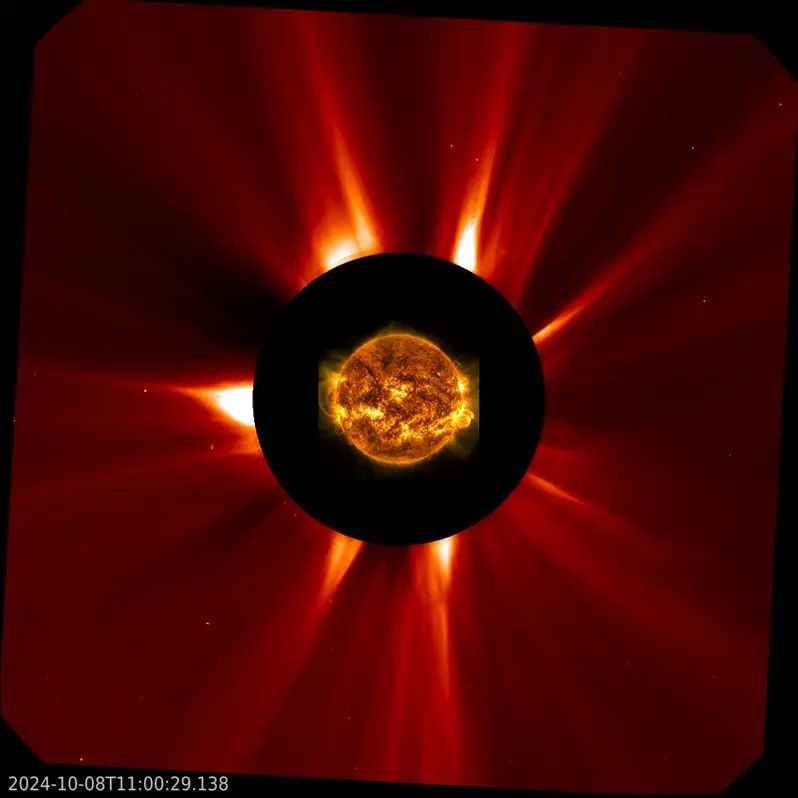
The sun erupted with an X1.8 solar flare at 1:56 UTC on October 9. This SOHO spacecraft imagery shows that it sent a halo coronal mass ejection (CME) our way, and produced a confetti-like solar particle storm. It also captured the amazingly bright Comet A3 coming past the sun from the right of the frame. Images via SDO, SOHO, and jhelioviewer.
An X1.8 solar flare erupted from sunspot group AR3848, followed by a blast of solar material known as a coronal mass ejection (CME), creating a shock wave that propelled particles—visible as “snow” in images—to nearly the speed of light. AR3438 was the largest and most complex sunspot group on the solar disk at that time. AR3848 was located near the center of the disk, positioning it ideally to send solar material toward Earth—exactly what occurred.
When the CME reached Earth, it was anticipated to trigger another round of stunning auroras. The effects of that CME hitting Earth were spectacular leading to the next part of the October 2024 Super Storm, aurora far and wide.
The SOHO imagery also captured the bright Comet C/2023 A3 (Tsuchinshan–ATLAS) during its close approach to the sun, adding to the dramatic solar activity.
Auroras on Earth
October 10-11, 2024
- This event is focused on a different type of imagery, a photograph of aurora with a cellphone. Modern cell phones do a great job recording aurora, even when it cannot be seen by the naked eye.
- This image from this event is also interesting because it is from a location that does not normally experience aurora, especially aurora in all directions.
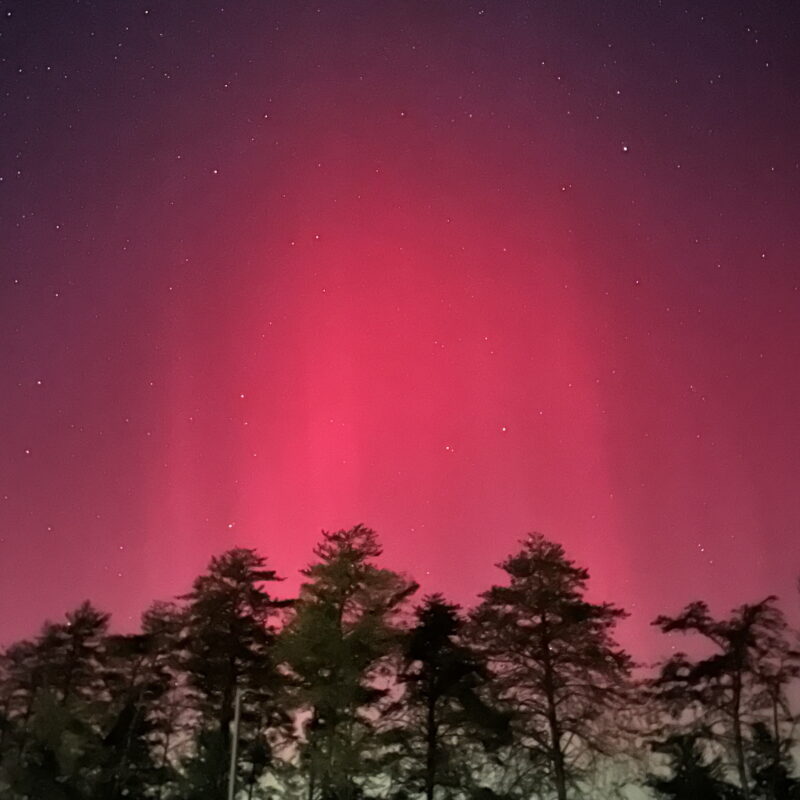
Many parts of the world enjoyed a night of fantastic aurora. This is a shot of red aurora from Maryland, U.S., on the night of October 10, 2024. Captured with an iPhone 14 Pro Max, this came from one of the several intense periods of activity. Image via Linda C. Schenk.
Sunspot region AR3848 released an X1.8 flare at 1:56 UTC on October 9, producing a halo coronal mass ejection (CME) directed straight toward Earth (refer to event 5). NOAA issued a G4 (severe) geomagnetic storm watch, predicting auroras that might be visible in the lower-tier U.S. states, even without cameras.
The CME arrived later that day, increasing solar wind speed and disturbing Earth’s magnetic field. The bulk of the CME—a significant blob of solar material and magnetic fields—struck Earth as anticipated, causing disruptions and igniting auroras.
Auroras became visible Thursday night and Friday morning, with reports from all lower 48 U.S. states and locations worldwide. This storm, triggered by the CME, rivaled the May 2024 superstorm. Strong to severe geomagnetic activity began shortly after the impact, fluctuating between G3 and G4 levels, with sporadic G1 and G2 periods. The most intense displays occurred in three to four periods, peaking around 9 p.m. and 12 a.m. EDT (1 to 4 UTC on October 11). These storms were second only two those of May 2024 for the year and Solar Cycle 25.
4: Biggest Flare of 2024 and Solar Cycle 25
October 3, 2024
- This flare is the largest of 2024 and the solar cycle but also the 15th largest flare in 28 years.
- The images showing this flare provide an example of what happens when the flare is large enough to create several types of artifacts.
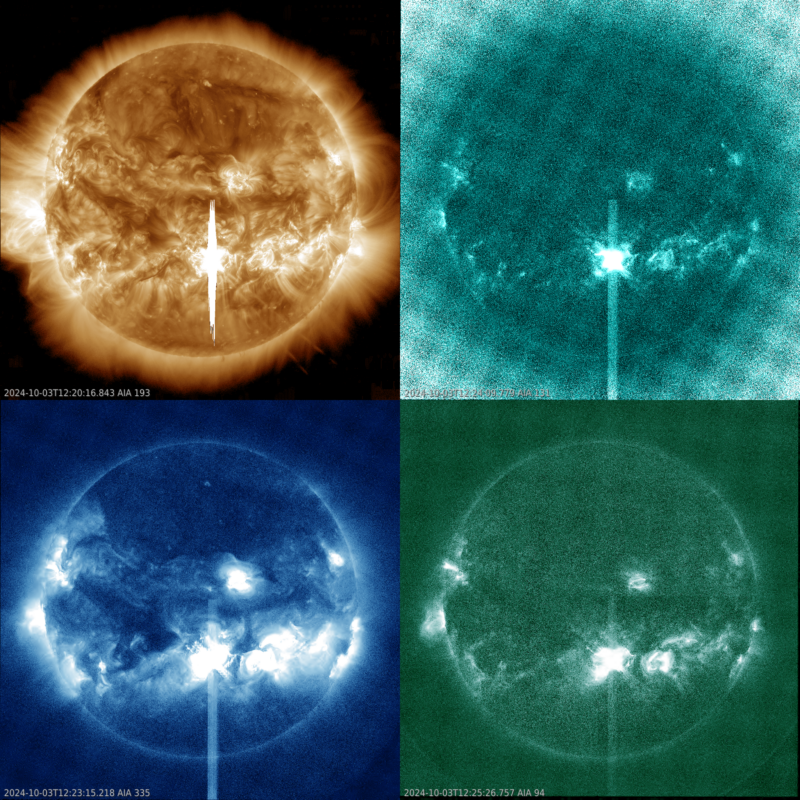
Active region AR3842 released an X9 flare during the middle of the day on October 3. It along with the X7.1 flares, both had associated CMEs that headed to Earth and caused auroras. Images via jhelioviewer and SDO
An X9 flare occurred close to the center of the sun’s disk, meaning the material blasted off the sun having a strong chance of being Earth-directed and it was. These “blobs” of solar material created auroras when they reached our planet.
It had been an active week for solar flares! On Tuesday, October 1, the sun released an X7 flare. Then, at 12:10 UTC on October 3, the sun unleashed the X9 flare—the largest flare of 2024 and Solar Cycle 25. Both flares came from sunspot region AR3842.
Material from the X7 flare was already on its way to Earth, then the X9 flare sent additional material in our direction. These events created vibrant auroras visible starting October 6 and continuing to October 8 with a slight break before the October 10-11 Super Storms and aurora, which were caused by eruptions after the October 3, 2024 X9 flare.
3: Total Solar Eclipse
April 8, 2024
- Here is a different type of observation than most. This is a simulation of the total eclipse observed from space.
- This event, unlike all the others on this list, is not a surprise; its time and location have been known for decades.
The virtual camera flies from the night side of the Earth and Moon to the day side, revealing the path of the Moon’s shadow during the April 8, 2024, total solar eclipse. CREDIT: NASA SVS
We hope you got to see the April 8, 2024, eclipse! After that, you’ll have to travel because you won’t see another one in the US until 2033 (Alaska), 2044 (Montana and North Dakota), or 2045 across the US!
The virtual camera showed the Earth and Moon from the night side to the day side, revealing the Moon’s shadow during the April 8, 2024, total solar eclipse. The umbra, the darkest part of the shadow, moved across Earth’s surface at over 1,500 miles (2,400 kilometers) per hour along the path of totality, marked in red. The shadow would have moved faster if Earth hadn’t rotated in the same direction as the Moon’s orbit.
The penumbra, shown in purple, marked the area where people could see a partial eclipse, with its edges outlined in yellow. Orange loops at each end of the eclipse path represented sunrise and sunset lines, where the eclipse began or ended at sunrise or sunset.
2: Parker Solar Probe Makes Closest Approach to the Sun
April 8, 2024
- Here is a different type of observation than most. This is a simulation of the total eclipse observed from space.
- This event, unlike all the others on this list, is not a surprise; its time and location have been known for decades.
🌞🤩👏 The Parker Solar Probe is currently undergoing its historic closest approach to the Sun. It reached the closest point, perihelion, at 11:52 UTC today, less than 15 minutes ago. Wow! What an amazing mission, and what an amazing moment! Keep on going, Parker! 🫣 😱 😮 pic.twitter.com/5elGiFYB1Y
— Dr. C. Alex Young (@TheSunToday) December 24, 2024
This animation from the Parker Solar Probe mission site displays the current conditions of the spacecraft. This video was captured near the time of the closest perihelion on the morning of December 24, 2024. CREDIT: JHUAPL
The Parker Solar Probe reached its historic closest point to the Sun, perihelion, at 11:53 UTC (6:53 a.m. EST) on December 24, 2024. At this point, it reached speeds around 430,000 miles per hour (692,000 kilometers per hour), flying within 3.8 million miles (6.1 million kilometers) of the visible surface of the Sun (photosphere).
🫣😱 Woohoo! Parker Solar Probe completed its closest approach to the Sun on Dec. 24. 😅 Mission operation at APL received the signal notifying success from the spacecraft late Dec. 26 just before midnight (EST) or Dec. 27 around 5 UTC. 🌞🚀🥳👏🎉 MORE on Parker at… pic.twitter.com/IHEjf1Bqvq
— Dr. C. Alex Young (@TheSunToday) December 27, 2024
This animation is an artist’s rendention of the Parker Solar Probe making its closest perihelion on December 24, 2024. CREDIT: NASA SVS
Parker Solar Probe completed its closest approach to the Sun and the mission operations at JHUAPL received the signal (green beacon) notifying success from the spacecraft, late on December 26, 2024, just before midnight (EST) or December 27, 2024, around 5 UTC.
1: May 2024 Super Storms
The Events at the Sun
May 7-11, 2024
- Mutiple events at the Sun led to the geomagnetic storms at Earth along with aurora. They happened over several days including several X and M flare and the associated coronal mass ejections (CMEs).
- The events at the Sun presented here are presented in a set of three videos. The last video also includes the predictions of activity at Earth.
🌞 📰 Sun news for May 8, 2024: X and M flares all day long
🫣 🤩 😱 Sun activity is very high today with the production of 2 X flares and multiple M flares. Two active sunspot regions are the culprits: AR3663 and AR3664
🧐 MORE at EarthSky: https://t.co/xD29wLfm4e pic.twitter.com/PCk2dHkvqD
— Dr. C. Alex Young (@TheSunToday) May 8, 2024
Sun activity was very high starting around May 7, 2024. Sunspot regions AR3663 and AR3664 each produced X flares on May 8, 2024. CREDIT: GOES/NASA/jhelioviewer
🌞 📰 Sun news for May 9, 2024: Two X flares and many M flares
🫣 🤩 😮 AR3664 fired two X flares during the observation period.
🤔 😱 An X1.0 late yesterday and an X2.3 flare at the time of this writing.
🧐 MORE at EarthSky: https://t.co/xD29wLfm4e pic.twitter.com/2aQXBHsCT5
— Dr. C. Alex Young (@TheSunToday) May 9, 2024
Two more X flares and numerous M flares came from AR3664. An X1.0 flare on May 8, 2024, and an X2.3 flare on May 9, 2024, added to the coronal mass ejections (CMEs) headed to Earth. CREDIT: GOES/NASA/jhelioviewer
🌞 📰 Sun news for May 10, 2024: Severe solar storm to bring auroras!
🫣 😱 🤩 Strong to severe geomagnetic activity is anticipated starting later today into tomorrow.
Chances for auroral displays to mid and low latitudes!
🧐 MORE at EarthSky: https://t.co/xD29wLfm4e pic.twitter.com/lEQTd2BDMo
— Dr. C. Alex Young (@TheSunToday) May 10, 2024
All eruptions starting on May 7, 2024, began the train of CMEs headed to Earth. Space weather analysts predicted severe geomagnetic storms and many were surprised that the higher extreme level was reached. CREDIT: GOES/NASA/jhelioviewer
The Sun developed a large, complex group of sunspots called NOAA region 13664. This region and another active area produced an astonishing number of solar flares. From May 3 to May 9, scientists observed 82 significant flares. During this period, the Sun unleashed several X-class flares:
May 8: X1.0 flare
May 9: X2.25 and X1.12 flares
May 10: X3.98 flare
May 11: X5.4 flare (the strongest of the series)
Along with the flares, the Sun also expelled huge clouds of solar material called coronal mass ejections (CMEs). Between May 7 and 9, at least seven CMEs were launched towards Earth. The train of CMEs combined into a complex cloud of plasma and magnetic fields that impacted Earth’s magnetosphere. This led to the next stage of the May events, a series of geomagnetic storms that were predicted to reach severe levels but ended up becoming stronger, extreme.
Auroras on Earth
May 10-11, 2024
- The number one solar event is not unlike the October Superstorm event in terms of the kind of imagery we have to share from all over the world.
- At the same time, the top of our list is unique because this produced such a huge and unexpected aurora that it became almost a truly global event. The jury is still somewhat out, but the May storms are arguably a generation, maybe once-in-a-lifetime, occurrence.
The video starts with the explosion of aurora images from Europe then shows a selection of the amazing photos from twitter shared as the auroras spread from Europe to North America. Then imagery from the Solar Dynamics Observatory (SDO) and the Solar Heliophysics Observatory (SOHO). This shows the intitial eruption, flare, and coronal mass ejection (CME) on May 5, 2024. There is a particle storm observed by SOHO. This is the beginning of train of CMEs that drove the geomagnetic storm that sparked the auroras.
On May 11, 2024, an auroral explosion lit up skies across the globe. The anticipated geomagnetic storm exceeded expectations, reaching a G5 (extreme) level of activity. A series of coronal mass ejections (CMEs) arrived earlier than predicted, reaching Earth late on May 10. One or more faster CMEs overtook a slower one in a “cannibal event,” amplifying the geomagnetic disturbance to unexpected levels.
This storm became the largest geomagnetic event of the past 20 years and the strongest of Solar Cycle 25. It reached the level of a solar “superstorm,” only slightly smaller than the famous November 2003 Halloween superstorm. Aurora reports first came from Europe and New Zealand, followed by sightings across the Americas, including as far south as Mexico, the Florida Keys, and the Bahamas, and as far north in the Southern Hemisphere as Chile and Argentina.
HONORABLE MENTIONS
It’s solar max! You didn’t think we could only do 10, did you?!
Almost-X Flare, Big Eruption, and a Record Particle Storm
June 7, 2024
- First this event is just interesting to observe. Though it is fairly short, a lot is going on. It turns out to be a space weather event with all three parts: a flare, a coronal mass ejection (CME) and a solar particle storm.
- This eruption is scientifically exciting because it shows a moderate flare that produces a coronal mass ejection that quickly accelerates solar particles. These particles became the 3rd largest particle storm for 2024. They created the snow in the image as they hit the camera.
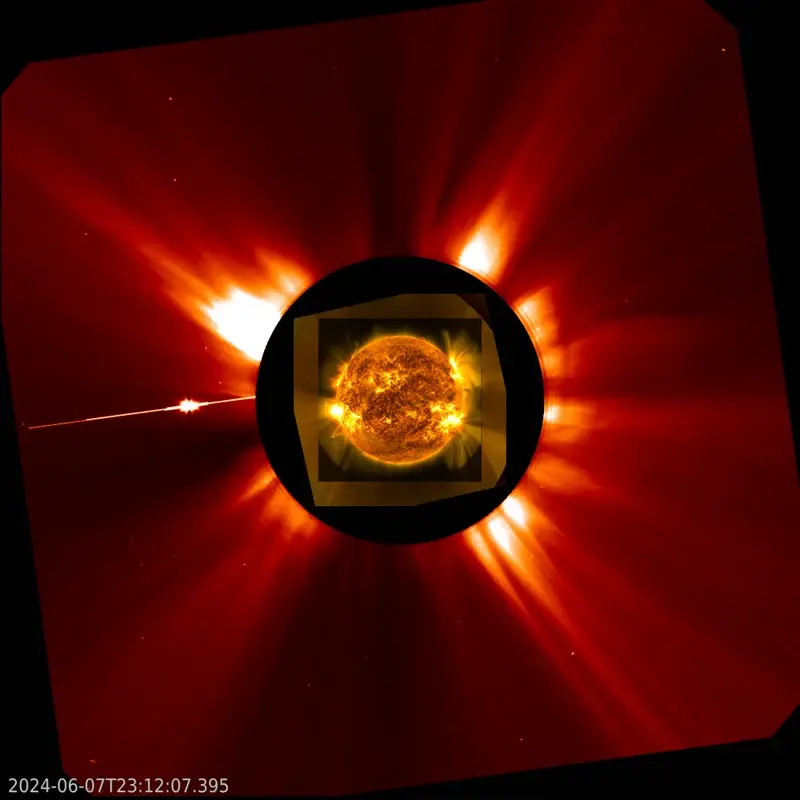
Sunspot region AR3697 erupted with an M9.8 flare (almost an X flare), and a filament. It created an S3 particle storm. Composite image via SDO and SOHO. By the way, the white dot moving outward from the sun is the planet Venus, the brightest planet visible from Earth. Venus passed behind the sun from our earthly point of view last week.
The giant sunspot region AR3697 became active again. This historic sunspot group had already produced the largest flare and one of the strongest geomagnetic storms of Solar Cycle 25. Near the end of its rotation across the Earth-facing side of the sun, it released an M9.8 flare—just below the X-class threshold—accompanied by a spectacular filament eruption.
This eruption released massive energy, creating a shock wave that accelerated protons and electrons to nearly the speed of light. These particles traveled along the sun’s magnetic field to Earth, causing “snow” in the SOHO/LASCO coronagraph images. The solar energetic particle event triggered an NOAA S3 radiation storm alert, later reduced to S2.
Powerful X Flare Blasts Particles from the Limb
February 10, 2024
- Another great example of a trifecta: flare, coronal mass ejection, and particle storm.
- This event was different than the previous pick because it was not Earth directed but it had a larger flare, though a smaller particle storm. The images of the flare show it was a very powerful event but less impactful for Earth because it was on the side of the Sun and partially blocked by the Sun itself.
? ? ? ? ? Kaboom!! Another look at the X flare – X3.4 from AR3575 around the W limb. It produced a fast CME over 2,000 km/s, 7.2 million kph. The location sent particles our way showing up as snow on the camera showing the CME.? ?
MORE at EarthSky: pic.twitter.com/jdT40RK8o0
— Dr. C. Alex Young (@TheSunToday) February 9, 2024
Another look at the X flare—X3.4 from AR3575 around the W limb. It produced a fast CME over 2,000 km/s, 7.2 million kph. The location sent particles our way, showing up as snow on the camera showing the CME.
An X3.4 flare, the most powerful type of solar flare, peaked at 13:14 UTC yesterday. It originated from sunspot region AR3575, which had recently rotated out of view over the sun’s southwest edge. Because the sunspot was partially blocked, the flare was likely stronger than X3.4.
The flare produced a fast coronal mass ejection (CME) traveling over 2,000 kilometers per second (about 4.3 million miles per hour). However, due to the flare’s position on the sun’s limb, the CME is not expected to head toward Earth. Shortly after the flare, an R3 (strong) radio blackout affected an area over the South Atlantic Ocean.
The eruption also generated a surge of high-energy protons traveling near the speed of light. These particles reached the SOHO spacecraft, causing “snow” on its LASCO coronagraph images. The solar energetic particle (SEP) event caused proton levels detected by the GOES spacecraft to rise, triggering S1 and later S2 alerts. Although the particle levels began stabilizing, they remained elevated.
Humongous Prominence!
April 19, 2024
- This video highlights a huge prominence on the limb (edge) and provides scale using the Earth to illustrate just how massive the Sun is and how large these types of phenomena can be.
- This particular event is also a good example of the benefit of multiple views and spacecraft observing the Sun and its surroundings. It also gives a nice overview of many different things happening, not just the primary focus, the giant prominence.
Sun news for Apr 19, 2024: Humongous prominence!
The sun let out a big burp of solar plasma that dwarfed the planet Earth!
Flaring on the sun continues at moderate levels.
STEREO-A H1 saw comet 12P have its tail pulled away by a CME.
MORE at EarthSky: https://t.co/xD29wLfm4e pic.twitter.com/iQuGDLFDgT
— Dr. C. Alex Young (@TheSunToday) April 19, 2024
This video from April 19, 2024 is focused primary on an enourmous prominence moving over the south eastern limb (edge) of the Sun. It starts with the GOES satellite which shows a larger field of view then uses SDO which gives more detail. Both these start with the 304 angstrom wavelength, best for observing prominences. The video also shows some moderate flares that day along with coronagraph views of the Sun and a comet. Images via NASA, NOAA, and jhelioviewer
The sun released a massive burst of solar plasma today in the form of a gigantic solar prominence. These structures, called filaments when seen on the solar disk and prominences when hanging over the sun’s edge, consist of material from the chromosphere—our star’s lower atmosphere. This material, at about 80,000 kelvin (143,000°F), was suspended by magnetic fields in the much hotter corona, which exceeds a million kelvin (1.8 million°F).
Sometimes prominences become unstable and erupt as coronal mass ejections (CMEs), which can create auroras if they reach Earth. Other times, they fall back to the sun or simply dissipate. This prominence, visible in GOES-R spacecraft imagery, largely dissipated. However, a CME might also have formed, and data from the SOHO spacecraft is needed to confirm. Either way, it was enormous!
We hope you enjoy the highlights! 2025 should have more excitement since solar max is not over, and we will learn more from Parker Solar Probe’s close encounter with the Sun.


